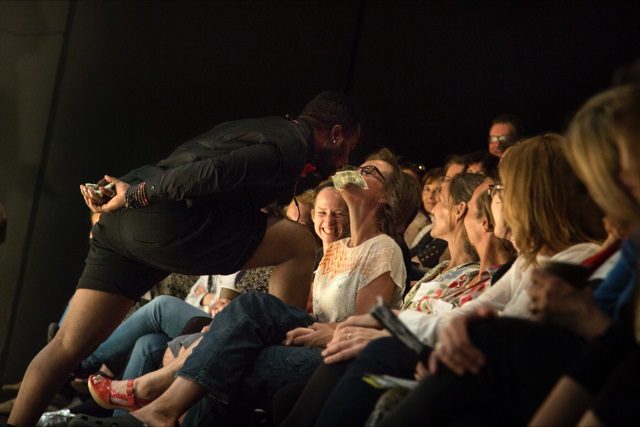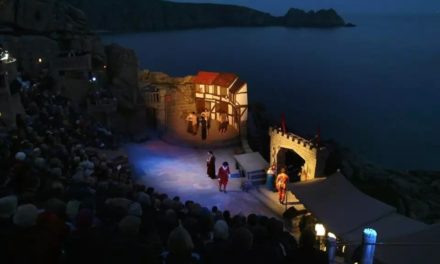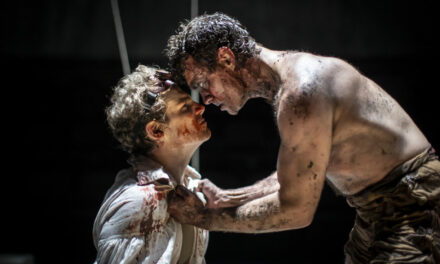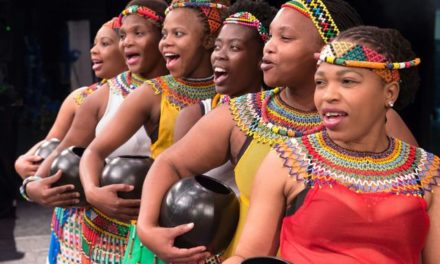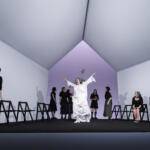When can performing arts be considered culturally diverse and inclusive? Where will new initiatives come from to further such diversity? And when do good intentions become exclusion?
The Danish Art Council’s annual conference focused on the subject of cultural diversity in the performing arts and addressed current trends. I listened in on the many speeches, talks, and workshops that day.
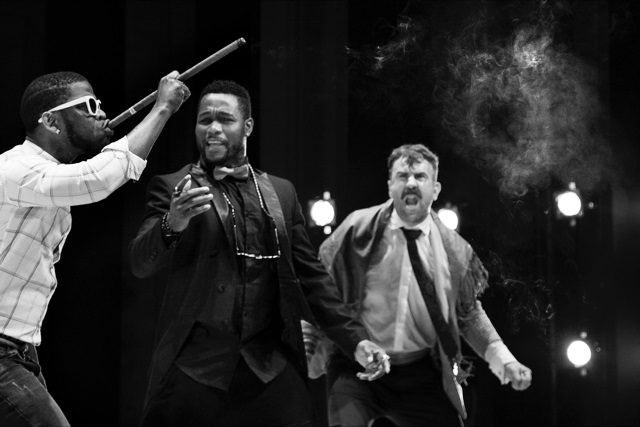
Photo by Frida Gregersen
“The world needs heroes!” sounded the ferocious cry from the colorfully dressed heroes who opened the Danish Arts Council’s annual conference, at the Royal Theatre’s Playhouse in Copenhagen, Denmark, in June this year. The conference was part of the annual performing arts festival CPH Stage, held in Copenhagen each year in the spring.
Most of the Danish theatre industry had gathered here for a day dedicated to the subject of and discussions on cultural diversity in the performing arts.
It was Theatre Glad’s artists who, in an interactive performance piece, guided us audience members through the three tests which a hero must undergo – and we passed.
It quickly became clear that not only society but also the performing arts industry need superheroes if the industry is to overcome the challenges it presently faces in reflecting our society in times of change and to serve as a platform for the increasing diversity in our society.
The conference featured several speakers from Denmark and abroad, each of whom shared reflections on how to define the term cultural diversity in relation to performing arts.
Because what exactly is cultural diversity? Is it an artistic project, an incentive for integration or a new way of breaking with conventions of the traditional arts? Who will benefit from greater cultural diversity in the performing arts? And where should the push for such diversity begin and end? Should this push involve artistic boards, performing arts schools and training, and those at the management level, or should it be solely an artistic initiative? And from where should the initiative for furthering cultural diversity originate?
The chairman of the performing arts department of the Danish Arts Council, Ditte Maria Bjerg, pointed out that within performing arts in Denmark there is currently great progress on gender equality but less when it comes to ethnic minorities.
This prompted the Arts Council to ask, “How is cultural diversity presented in terms of ethnicity in performing arts?”
Anne Schulz, of the Müncher Kammerspiele, kicked off the conference with a talk on how the Kammerspiele recently embraced the idea of cultural diversity in the theatre space. Schulz works with audience development and is determined to make theatre interesting for children, younger audiences, students, and indeed for refugees. When the flow of refugees peaked in Germany in 2015, Schulz asked rhetorically: “How can we open up the theatre [for these refugees], and what are the specific needs?”
There was an abundance of ideas; and with previous experience from, amongst others, the city of Dresden and input from volunteer groups, several activities were initiated. One of these was a “Welcome Cafe,” established by the theatre to serve as a sanctuary for refugees, where they could drop by unannounced for dinner, a coffee, a board game, choral singing, and other activities.
Schulz told us: “For the project to succeed, it needs to be management’s top priority. Since there is a great fear of doing the wrong thing in relation to refugees, there is a need for people to just take the initiative and then face the problems as they go along.” And the problems arose: Where do you, for instance, draw the line in relation to integration?
Schulz asked: “Can we establish a beauty salon solely for women to encourage them to join the flow of refugees visiting the cafe, who primarily seem to be young men, or would that be gender exclusion?” Should performances be presented as “refugee theatre” to give the project a particular focus, or might that push audiences away? Or are cast members indeed still to be considered refugees if they have resided in the country for several years?
Schulz and her team made all their initiatives possible together with several other proposals such as exchange of artistic ideas, concerts, readings and performances for teenagers. And when right-wing forces began to tag racist messages around München, Schulz and her team created a hate-poetry-slam-space, where the edges of the rough expressions could be smoothed in a comical form.
To Schulz, the objective is to reflect our society’s diversity in groups and ethnicity in every aspect of the theatre–on the stage, in the auditorium, and at the management level – and there is still much to be done. At the Müncher Kammerspiele, however, not all of the projects and initiatives have space on the main stage, and its ensemble members do not yet reflect society’s ethnic and cultural diversity.
The question remains: Who should take the initiative and where should such incentives originate–with politicians, practitioners, or artists?–and with what agenda?
Another speaker at the conference was Hassan Mahamdallie, the British specialist in diversity and equality in the arts. His response to the question was very clear: practitioners and artists should pave the way. He finds that it is a waste of our efforts to try to predict politics, which is why practitioners and artists themselves need to push their own agenda and to take much greater risks than they do at the moment if the performing arts industry is to innovate itself.
Mahamdallie also pointed out that diversity “just is;” it is innate in us all as human beings, and it is the core of the artistic process. To Mahamdallie, diversity is what advances the performing arts.
Mahamdallie used as examples historical cases, such as when Georg Balanchine was a choreographer with the New York City Ballet and insisted on having five classically trained ballet dancers on stage together with five African American dancers from Harlem, New York City. “Why did Balanchine do this?” Mahamdallie asked us and answered himself: “Because Balanchine wanted to see what the African American style of dancing did to the classical ballet.”
Mahamdallie made it clear that he believes it is in artists’ and practitioners’ interest to challenge the performing arts industry, to make it self-innovating. At the same time, they need to remain self-led in relation to political agendas, as politicians typically think conservatively.
Mahamdallie used the National Theatre in Wales as an example of this. Here the artists did not wait for political consensus but chose themselves not to have permanent residency in a theatre space or building. Instead, they located themselves in Cardiff for rehearsals and subsequently toured the country with their productions. This way, they reached a broader audience in the local counties than if their performances were performed solely in a permanent space.
In the afternoon of the conference, there were six workshops to choose between. One of them was led by Åsa Ryvarden (Artistic Director at the Norwegian Theatre) and Egil Bjørnsen (Associate Professor at Telemark University College, Norway). Their workshop was titled The Organization And Management, and Ryvarden presented the Norwegian Theatre’s education project. The ambition of the project is to better reflect society’s cultural diversity, and therefore the theatre has established a training program for acting students who are considered to have a “family background outside Europe.” The project was set up in 2012 and is a three-year undergraduate program with six students in each year group.
“When the Norwegian society changes then the theatre has to reflect this. Because of this we need to have actors who reflect our society, and this is an artistic initiative, not a philanthropic project,” Ryvarden pointed out. At the same time, she made it clear that all the drama students were accepted into the training program based on their great artistic merit and not because they each represent an ethnic minority. Because no one wants to be a representative of “something different.”
Ryvarden was, however, asked by a member of the audience: “Is this not some kind of stigmatization to have a training program solely for students of other ethnic heritage?” Ryvarden replied that in Norway it is extremely difficult to get accepted into the established drama schools. And since the current cultural diversity in professional actors does not reflect the society as it currently stands, it is imperative that other initiatives exist.
That there is a demand for greater cultural diversity seems to have been established, since most of the graduates of the Norwegian Theatre’s education project have been employed at established theatres in Norway.
As the conference concluded, its many speeches and reflections could lead to the brief conclusions that cultural diversity in the performing arts is a comprehensive issue and a complex topic with many intrinsic challenges. If anything, it became clear that there are no easy solutions, but many concurrent initiatives can support the performing arts in moving into our modern society of cultural diversity and thereby becoming an artistic universe that truly reflects the surrounding society.

Photo by Frida Gregersen
Edited and translated by Pernille Thisted
Reposted with permission from IScene: https://iscene.dk/
This post was written by the author in their personal capacity.The opinions expressed in this article are the author’s own and do not reflect the view of The Theatre Times, their staff or collaborators.
This post was written by Rie Hammer.
The views expressed here belong to the author and do not necessarily reflect our views and opinions.

